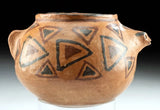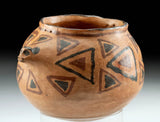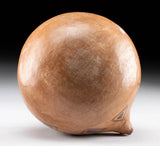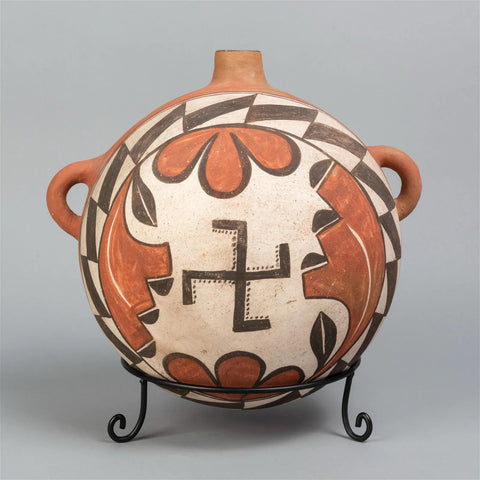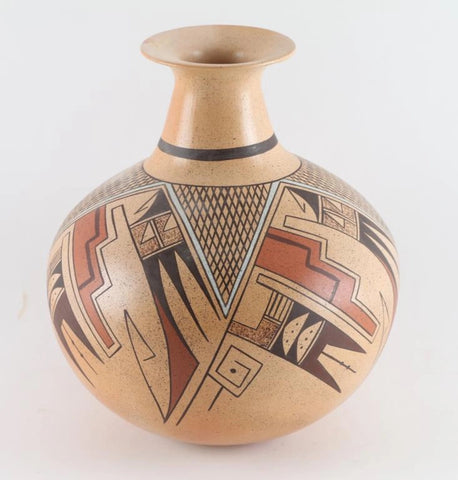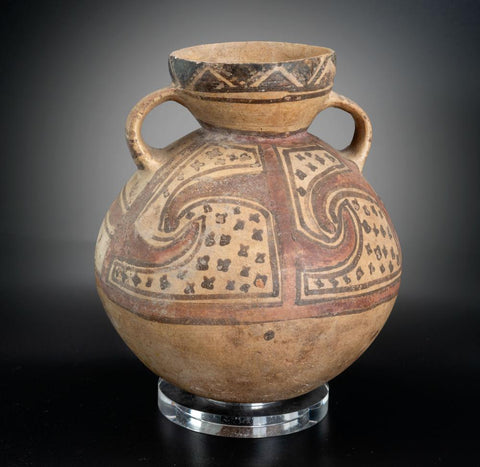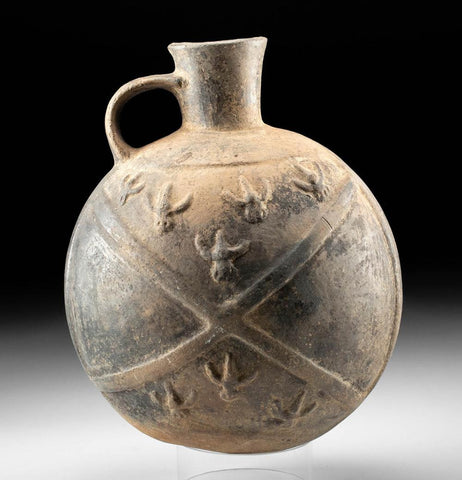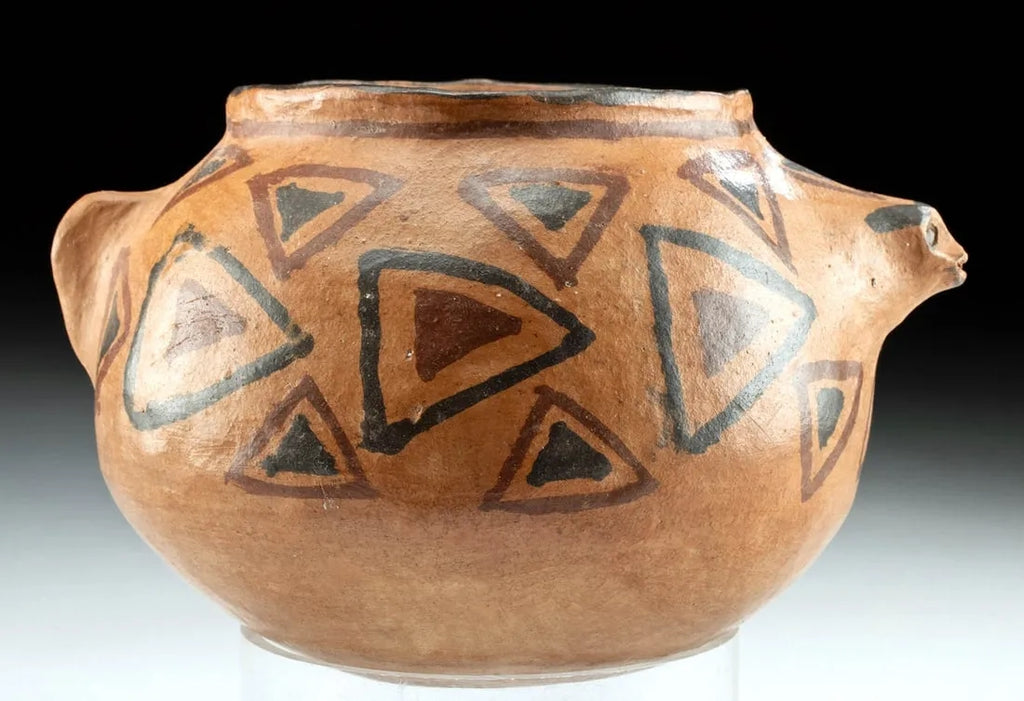
Casas Grandes Ramos Polychrome Jar CA 1250 to 1450 CE with Animal Head #1783
$ 2,500.00
Casas Grandes Ramos Polychrome Jar CA 1250 to 1450 CE with Animal Head #1783.
Description: Pre-Columbian, Northwest Mexico, Chihuahua, Casas Grandes, Ramos, CA 1250 to 1450 CE. A hand built pottery jar showcasing a zoomorphic head lug in relief and triangular motifs painted over the slipped orange surface. On both sides of the rim are a pair of petite drilled holes allowing the vessel to be suspended or perhaps to attach a lid in place.
Dimension: 7" Diameter x 5" H (17.8 cm x 12.7 cm)
Provenance: Private La Crescenta, California, USA collection, before 2000
Condition: Excellent condition. Some fading and minor chips to surface and pigments, but otherwise intact.
"First posted by C. Dean Wilson 2014: Ramos Polychrome was defined by Sayles (1936). This type is characterized by a white to light gray paste and surfaces. Paste is white or buff to tan in color (DiPeso 1974). Pastes tend to be hard and sometimes vitreous, and appear to have been fired to a high temperature in an oxidizing atmosphere. Surfaces are often poorly polished and not slipped and light (white, yellow, buff or tan) in color. This type appears to exhibit very fine-grained temper if any is observable at all. Vessels tend to be evenly and consistently shaped, often exhibiting an almost sculptural appearance. Vessel forms often consist of steep neck less jars that gradually slope end ward, ollas with globular bodies and straight narrow openings, steep bowls and effigies. Ramos Polychrome is by far the most common Casas Grandes type occurring in low frequencies across much of the Southern New Mexico and may be relatively common in assemblages in extremely Southwestern New Mexico (particularly the boot hill) where it is often the most common decorated type".
"Ramos Polychrome is characterized by fine line work in black and red. The bold red motifs, include triangles, step triangles, circles, and long ribbons, and are often outlined in thin, even, and precisely executed black design. Designs in black often consist of intricate combinations of thin parallel and curvilinear lines, solid geometric motifs similar to that noted in the red designs as well as elments filled with hachure lines or checkerboard spaces. These designs are also may include anthrophic depictions of life forms macaws and awanyus. These decorations are also organized into two to four integrated panels that cover all but the very bottom of most exterior surfaces. Together the effect produced by the black and red designs is surprisingly variable and stunning, often consisting of intricate combinations of bold and more precisely executed geometric shapes sometimes with and sometimes without stylized lifeforms. Rare examples of pottery assigned to this type have sometimes been placed into the Capulin variant, distinguished by the use red elements not outlined by black lines. The Memmott variant refers to forms where the solid decorations are entirely executed in black paint with red decorations limited to framing lines. A black-on-white variant exhibits a red painted base, and the body and shoulders of the jar has black line work. It is therefore possible to observe sherds that are only black-on-white (DePeso and others 1974".( Source: Office of Archaeological Studies, Pottery Typology Project)
References:
DiPeso, Charles C., John B. Rinaldo, y Gloria C. Fenner
1974 Casas Grandes: A Fallen Trading Center of the Gran Chichimeca,Vol. 6: Ceramics and Shell. Amerind Foundation Publications 9(4–8). Northland Press, Flagstaff.
Sayles, E.B. 1936 Archaeological Survey of Chihuahua, Mexico. Medallion Paper 22. Gila Pueblo, Globe.
Description: Pre-Columbian, Northwest Mexico, Chihuahua, Casas Grandes, Ramos, CA 1250 to 1450 CE. A hand built pottery jar showcasing a zoomorphic head lug in relief and triangular motifs painted over the slipped orange surface. On both sides of the rim are a pair of petite drilled holes allowing the vessel to be suspended or perhaps to attach a lid in place.
Dimension: 7" Diameter x 5" H (17.8 cm x 12.7 cm)
Provenance: Private La Crescenta, California, USA collection, before 2000
Condition: Excellent condition. Some fading and minor chips to surface and pigments, but otherwise intact.
"First posted by C. Dean Wilson 2014: Ramos Polychrome was defined by Sayles (1936). This type is characterized by a white to light gray paste and surfaces. Paste is white or buff to tan in color (DiPeso 1974). Pastes tend to be hard and sometimes vitreous, and appear to have been fired to a high temperature in an oxidizing atmosphere. Surfaces are often poorly polished and not slipped and light (white, yellow, buff or tan) in color. This type appears to exhibit very fine-grained temper if any is observable at all. Vessels tend to be evenly and consistently shaped, often exhibiting an almost sculptural appearance. Vessel forms often consist of steep neck less jars that gradually slope end ward, ollas with globular bodies and straight narrow openings, steep bowls and effigies. Ramos Polychrome is by far the most common Casas Grandes type occurring in low frequencies across much of the Southern New Mexico and may be relatively common in assemblages in extremely Southwestern New Mexico (particularly the boot hill) where it is often the most common decorated type".
"Ramos Polychrome is characterized by fine line work in black and red. The bold red motifs, include triangles, step triangles, circles, and long ribbons, and are often outlined in thin, even, and precisely executed black design. Designs in black often consist of intricate combinations of thin parallel and curvilinear lines, solid geometric motifs similar to that noted in the red designs as well as elments filled with hachure lines or checkerboard spaces. These designs are also may include anthrophic depictions of life forms macaws and awanyus. These decorations are also organized into two to four integrated panels that cover all but the very bottom of most exterior surfaces. Together the effect produced by the black and red designs is surprisingly variable and stunning, often consisting of intricate combinations of bold and more precisely executed geometric shapes sometimes with and sometimes without stylized lifeforms. Rare examples of pottery assigned to this type have sometimes been placed into the Capulin variant, distinguished by the use red elements not outlined by black lines. The Memmott variant refers to forms where the solid decorations are entirely executed in black paint with red decorations limited to framing lines. A black-on-white variant exhibits a red painted base, and the body and shoulders of the jar has black line work. It is therefore possible to observe sherds that are only black-on-white (DePeso and others 1974".( Source: Office of Archaeological Studies, Pottery Typology Project)
References:
DiPeso, Charles C., John B. Rinaldo, y Gloria C. Fenner
1974 Casas Grandes: A Fallen Trading Center of the Gran Chichimeca,Vol. 6: Ceramics and Shell. Amerind Foundation Publications 9(4–8). Northland Press, Flagstaff.
Sayles, E.B. 1936 Archaeological Survey of Chihuahua, Mexico. Medallion Paper 22. Gila Pueblo, Globe.
Related Products
Sold out

